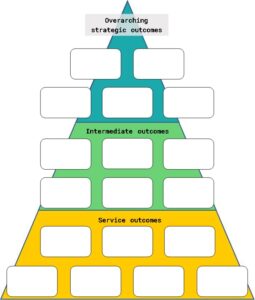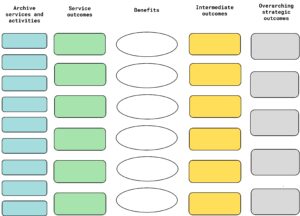Main section
The following examples suggest ideas to help you create an archives outcomes framework to illustrate the contribution to learning and education. Don’t be constrained by them; you can refer to the examples as much or as little as you want.
Ideally your outcomes framework will consist of four elements:
- Outcomes triangle
- Logic model
- Evidence
- Performance indicators
Tabs Navigation
Tabs
Outcomes triangle and logic model
Outcomes triangle
The outcomes triangle gives an overview of how archives can contribute at service, intermediate and overarching strategic outcome levels.

The outcomes triangle model
Outcomes could be:
Overarching strategic outcomes
- Economic growth and employment
- Increased wellbeing and greater social connectedness
- More children and young people achieving their learning potential
- Higher skills levels and increased social mobility
Intermediate outcomes
- Improved educational attainment amongst children and young people
- More people accessing lifelong learning
- Increased awareness and participation in local decision making
- More older people participating in mentally stimulating activities
- Improved understanding of place, local heritage and identity
Service outcomes
- Increased use of the archive as a learning resources by children and young people
- More people gaining new knowledge, qualifications and skills through archives
- More people accessing information about local decision making
- More people volunteering and involved in community life through archives
- More people continuing/taking up learning later in life
Logic model
The logic model illustrates the main links between service activities and local outcomes. This example suggest broad groupings of activities, benefits archives can offer to individuals, communities and places, and how these in turn contribute to the achievement of intermediate and overarching strategic outcomes.

A logic model template
Outcomes could be:
Archive activities
- Training, employment and mentoring schemes
- Support for research activity
- Support for community groups
- Volunteering opportunities
- Facilities and information provision
- Management, conservation and preservation of collections
- Development and outreach work
- Events, sessions and clubs
Service outcomes
- More people gaining new knowledge, qualifications and skills through archives
- More people continuing/taking up learning later in life
- More people volunteering and involved in community life through archives
- More people accessing information about local decision making
- Increased use of the archive as a learning resource by children and young people
Benefits
- Increased knowledge, skills and qualifications
- Increased confidence, self-esteem, personal responsibility and resilience
- Increased social interaction, new relationships and role models
- Improved understanding of local services and community issues
- Improved speech, language and communication skills
Intermediate outcomes
- More people accessing lifelong learning
- More older people participating in mentally stimulating activities
- Improved understanding of place, local heritage and identity
- Increased awareness and participation in local decision making
- Improved educational attainment among children and young people
Overarching strategic outcomes
- Economic growth and employment
- Higher skill levels and increased social mobility
- Increased wellbeing and greater social connectedness
- More children and young people achieving their learning potenial
Our section on ‘What to include‘ has more information about the outcomes triangle and logic model methods
Step two of ‘Creating your framework‘ features a step by step guide to creating an outcomes triangle and logic model
Evidence
The evidence section of the framework underpins the outcomes triangle and logic model. It lists the sources of evidence that together best demonstrate the contribution of archives to the outcomes.
We have identified an example of validated national evidence that demonstrate the contribution of archives to outcomes for learning and education. You may have other examples relevant to your local outcomes.
Stage three of ‘Creating your framework‘ contains a step-by-step guide to reviewing the evidence
‘The impact of volunteering in archives‘ (Archives & Records Association, 2018)
Research highlighting the impacts of volunteering in archives and how these affect volunteers, services, and the profession. Volunteers feel the long-term effects of improved health and well-being, new and re-enforced skills and enhanced prospects of employability.
Performance indicators
Below are suggestions of how to measure the contribution of archives to better outcomes across a number of policy themes. Not all of these suggestions will be relevant to your local outcomes.
You should select a small number of indicators from across the different levels that together best measure the contribution of archives to your service, intermediate and overarching strategic outcomes. Draw on available data from existing sources within your local council or organisation and elsewhere wherever possible.
Stage four of ‘Creating your framework’ has a step-by-step guide to selecting performance indicators
Overarching strategic outcome indicators
These are high-level non-archive indicators that you want to demonstrate, and can evidence that archives contribute towards. They are likely to reflect the overall responsibilities of key decision-makers; notably local government, but also other key stakeholder groups such as educational bodies.
Examples include:
- Overall employment rate
- Percentage of 16 to 18-year-olds who are not in education, training or employment
- Attainment at ages 16 and 19
- Self-reported wellbeing: satisfaction, happiness, anxiety and feel things are worthwhile
- Overall or general satisfaction with local area
- Percentage of local authority budgets delegated to local decision making
- Percentage of people who believe people from different backgrounds get on well together in their local area
- Percentage of older people who feel the contribution they make to their local community is valued
- School readiness: percentage of children achieving at least the expected level of development in communication, language and literacy skills
Some of these indicators may be drawn from non-council data sources.
Intermediate outcome indicators
These should include indicators that reflect the specific contribution of archives to the intermediate outcomes.
Examples include:
- Number of full-time equivalent (FTE) jobs supported by the archive visitor economy
- Number of service users accessing the archives to work towards a formal qualification
- Number of service users in the last X years who have gained a formal qualification partly as a result of working with the archives
- Number of people who think that the archive helps make their local area a nicer place to live and or contributes to local identity and pride
- Percentage of:
- children and young people who agree that participation in an archive project, activity or event has helped them feel happier about coming to school, or helped improve their concentration or behaviour, or helped them be more interested in classes or do better at school
- children and young people who agree that participation in an archive project, activity or event has given them the opportunity to demonstrate their talents and skills, or helped them feel more confident or positive about themselves
- young people who agree that participating, volunteering or training opportunities in archive projects, activities or events helped them get into or stay in education, training or employment
- parents, carers or teachers who agree that participation in an archive project, activity or event is improving children’s social interaction or skills
- participation in an archive project, activity or event has helped improve their confidence, self-esteem, communication or social skills
- participation in an archive project, activity or event has helped increase their understanding of how they can influence decisions in their neighbourhood or get involved in local decision making
- participation in an archives project, activity or event has made them want to get more involved in community social action or volunteering
Intermediate outcome indicators may also include non-archive indicators that are short to medium term ‘proxy’ measures for the overarching strategic outcomes.
Examples include:
- Emotional wellbeing of looked-after children
- School readiness (early years development)
- Percentage of young people participating in regular volunteering
- Achievement of children at the end of the Early Years Foundation Stage profile
Service outcome indicators
These are indicators specific to archives.
Examples include:
- Percentage of:
- children and young people, adults or older people accessing the archive for learning events
- participants who agree that through participation in an archive project or event they have learnt something new
- children and young people, adults or older people regularly volunteering in the archive
- children and young people, adults or older users satisfied with the archive provision in their local area
- residents who agree that archive provision, activities or events have increased their understanding of the local heritage
- young people or adults in formal or informal archive learning opportunities who achieve accreditation or qualifications
- Number of:
- partnerships with educational establishments and lifelong learning organisations including schools, academies, universities and third sector groups
- online resources and level of usage for learning/education
- staff obtaining professional qualifications as a result of their work in the archives
Service output indicators
These indicators are also specific to archives.
Examples include:
- Number of:
- young people and adults or older people participating in archive activities, project or events
- visits or participants in the archive offer (per 1,000 population)
- children and young people participating in archive activities during the school holidays
- young people at risk of offending engaged in positive activities through the archive
- young people, adults or older people participating in archive outreach activities
- young people, adults or older people regularly volunteering in the archive
- young people in employment, education or training with the archive
- young people gaining a recognised accreditation or qualification
- people accessing the archive service for the first time
- local organisations supported to gain skills
- events hosted with lifelong learning programmes and organisations such as U3A
Where useful indicators can be broken down further, for example, by geographic area or target wards or by specific groups, including different age groups or disadvantaged and or vulnerable groups.